What is Kimchi
Kimchi is a mix of spicy sauerkraut and other ingredients. However, kimchi is also culturally significant.
What kimchi means to Korea is one of the most beautiful stories of food I’ve ever had the pleasure of learning. For Koreans, Kimchi symbolizes national pride, love, family, and hope for the future.
So what is kimchi made of? It depends on who is making it and where you are trying it! In Korea, families use local and seasonal ingredients in their kimchi recipes; that is why there are over 200 types of kimchi, each unique.
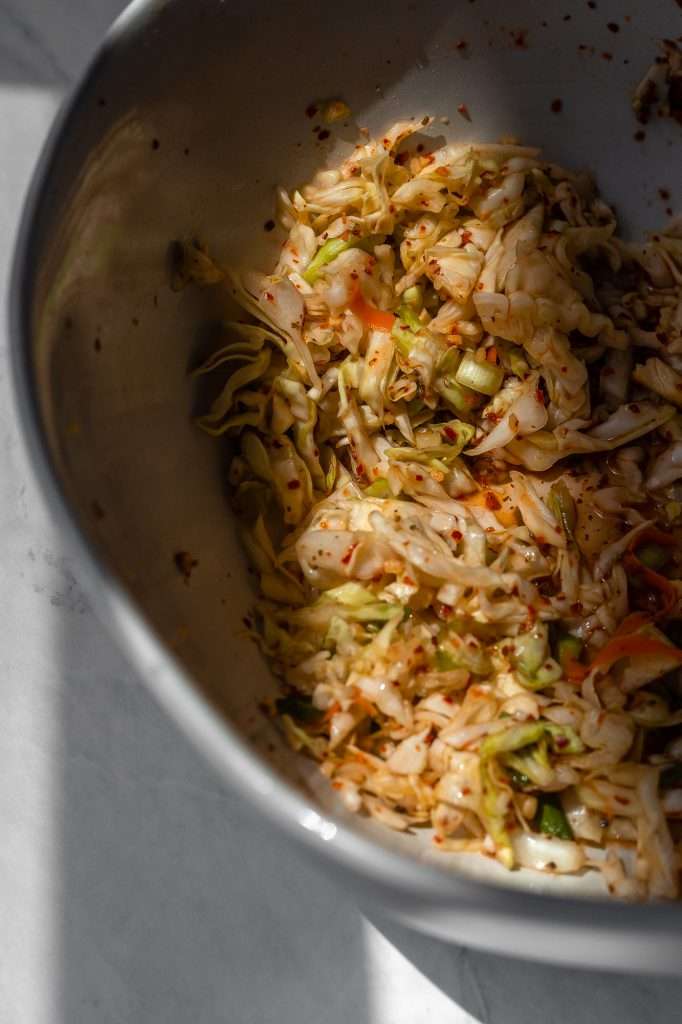
How to Make Kimchi
There are many ways to make kimchi with many different ingredients and methods.
The most well-known type of kimchi is Baechu Korean kimchi. You make it by soaking napa cabbage in a salty brine for 12 hours, then rinsing it and rubbing it with starchy paste.
Baechu kimchi includes salt fermented shrimp, fish sauce, gochugaru, sugar, ginger, garlic, radish, carrot, and scallions. Then it is packed into a fermentation crock and can be enjoyed after three days of fermentation at cool temperatures.
Some kimchi is ready to eat quickly because, in Korea, many people like it effervescent. Also, the salt fermented shrimp (Saeujeot) and fish sauce serve as vital salting agents, and Saeujeot introduces microbes to the kimchi fermentation process.

My Kimchi Inspired Spicy Sauerkraut Recipe
In this blog, you will learn how I make my original kimchi recipe, similar to how I make sauerkraut, but with added kimchi-inspired ingredients.
Thus, I call it kimchi-inspired spicy sauerkraut, or “kimchi sauerkraut”. I like that I have my original kimchi recipe, made with ingredients I can grow in my region and easily source. It’s a perfect addition to the over 200 unique kinds of kimchi worldwide.
Things You May Need:
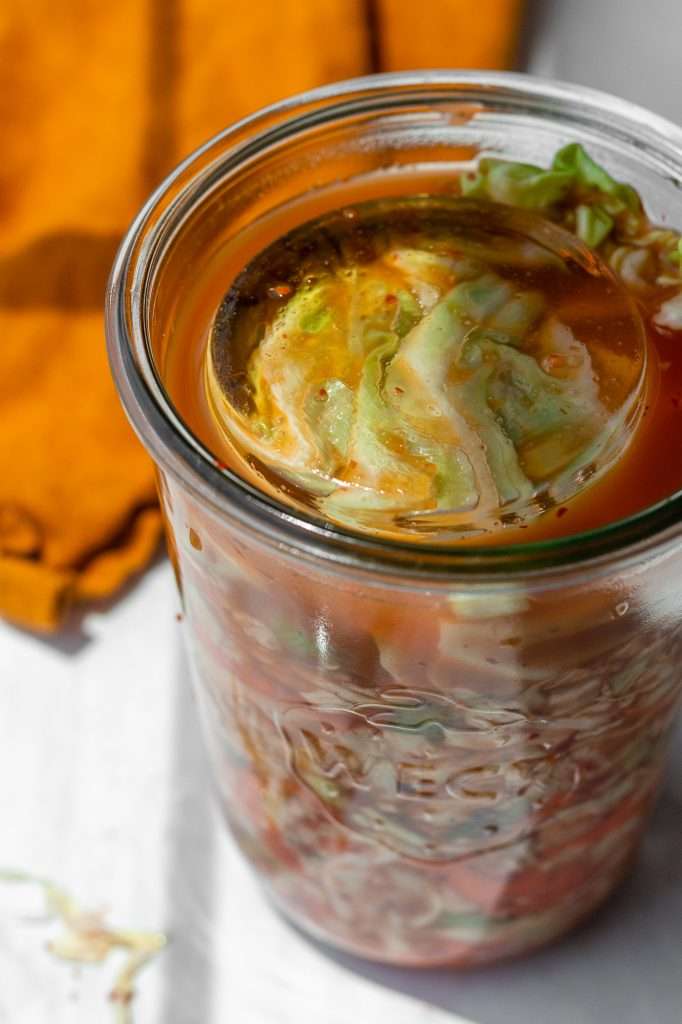
Kimchi vs. Sauerkraut
While kimchi and sauerkraut are fermented cabbage, they originate from different regions. Kimchi is from Korea, and sauerkraut originates from China. I know you thought sauerkraut was German.
While it was popularized in Germany in the 1800s, and its name is German, plain fermented cabbage is originally from china.
Historians say that 2000 years ago, enslaved people building the Great Wall of China began fermenting shredded cabbage in rice wine to preserve it so they would have a food source during the non-growing season.
Both kimchi and sauerkraut are probiotic-rich, healthy fermented foods. Kimchi has a deeper umami flavor because it incorporates more ingredients, while sauerkraut is more light and fresh.
Kimchi may be slightly more nutritious due to more bioavailable vitamins and minerals from the variety of ingredients used to make it.
What Does Kimchi Taste Like?
Kimchi tastes delicious, and I describe it as sour, salty, spicy, and umami (earthy, savory flavors).
The flavor of kimchi varies, just as kimchi recipes do. Many variables impact kimchi flavor, like the amounts of salt used, length of fermentation, and vegetables used.
Spicy Sauerkraut flavor
This sauerkraut tastes very similar to kimchi, but milder. People often tell me they are afraid to try kimchi. Then, when they try my spicy sauerkraut with kimchi spices, they can’t get enough of it.
How Long Does Kimchi Last
Everyone always wonders, can kimchi go bad? I’ve never had kimchi go bad, but I think it is because Jon and I eat it so fast. Between the two of us, we eat a gallon in under two months.
Kimchi can be stored in the fridge for a year, and I suggest eating it within six months for full probiotic benefits.
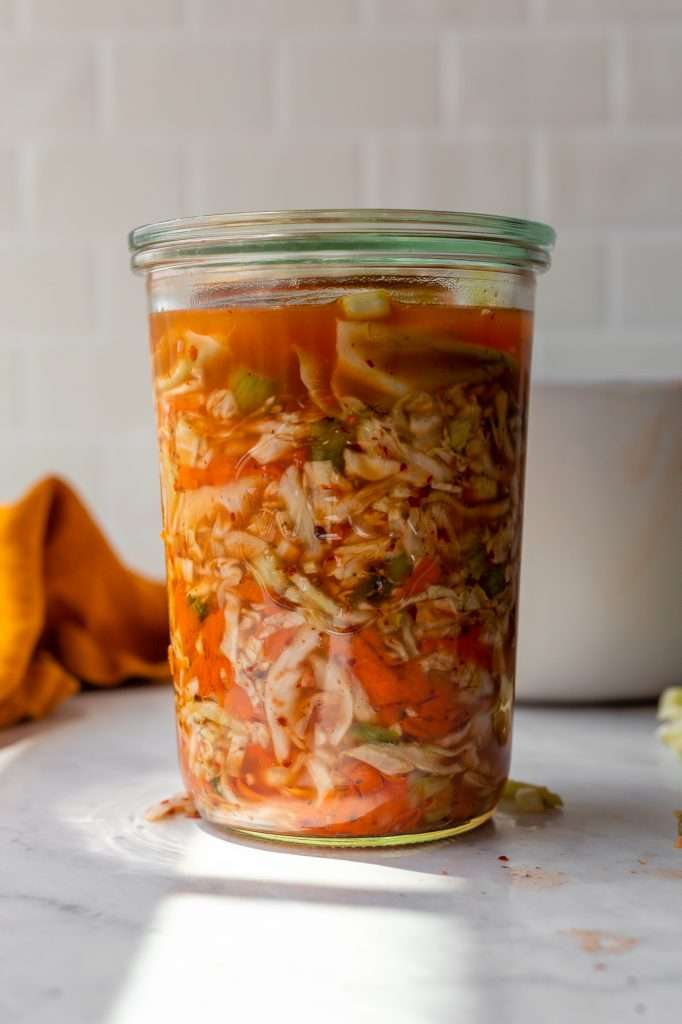
Spicy Sauerkraut Kimchi Spice Blend
This recipe calls for my kimchi spice blend. I blend these spices in bulk and keep them in an airtight jar so I can easily use the kimchi spice whenever I want to start a new batch.
This is a dry spice blend, and I use organic bulk spices from Starwest Botanicals.
Here is how I make it:
- You will need 455 grams gochugaru chili flakes, 300 grams minced garlic, 100 grams ginger powder, and 75 grams kelp granules.
- Mix the ingredients in a large bowl until evenly combined.
- Store in an airtight container, such as a mason jar or weck jar.
Recipes to Try
- The Best Kimchi Bloody Mary Perfect For Hangovers
- Oven-Baked Marinated Chicken Wings with Kimchi and Miso Sauce
- Fresh Vegan Summer Rolls with Creamy Kimchi Sauce
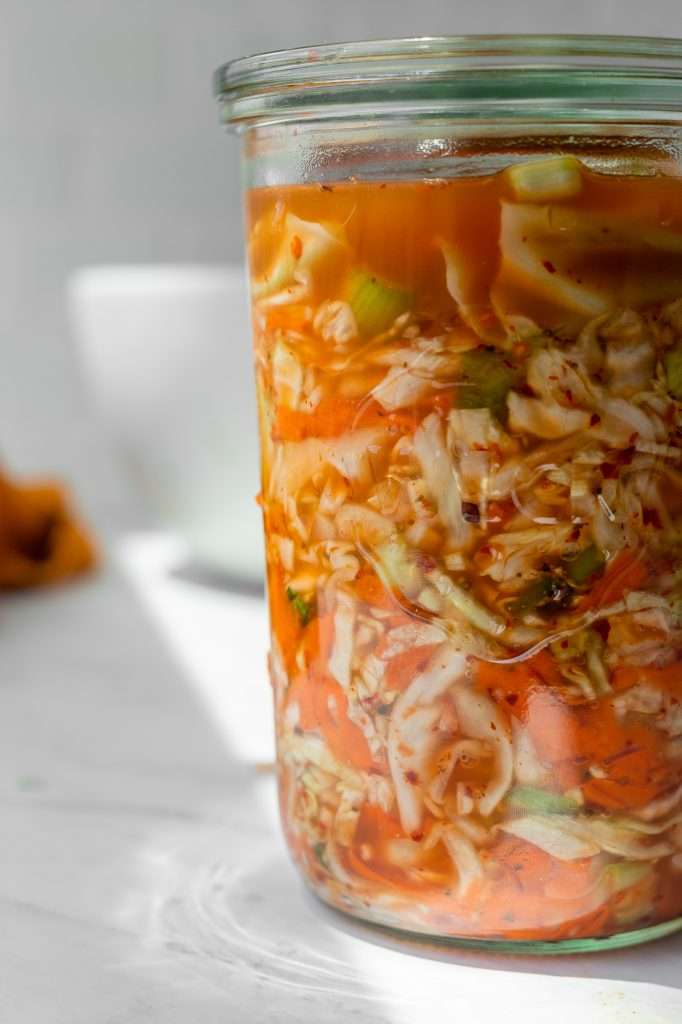
Homemade Kimchi Inspired Spicy Sauerkraut
What does kimchi taste like? It’s spicy, umami, sour and absolutely delicious! Learn how to make kimchi sauerkraut, a spicy sauerkraut recipe with delicious kimchi flavor.
- Prep: 10 minutes
- Total Time: 504 hours 10 minutes
Ingredients
- 500 grams green cabbage
- 20 grams unrefined sea salt
- 200 grams filtered water
- 15 grams kimchi spice blend*
- 75 grams carrots, julienned
- 30 grams green onions, chopped
Instructions
- Wash your fermentation equipment (jar, weight, and lid)
- Remove the outer leaves of your cabbage and lightly rinse with cool water. Using a knife, chop the cabbage to your desired thickness. Chop the carrots and onions.
- Place your kitchen scale on the counter. Turn it on and set it to weigh in grams.
- Measure out all of your ingredients using your kitchen scale.
- Mix all the ingredients, including the water, in a large bowl. Lightly massage the cabbage and break up any large pieces.
- Pack it all, including the water, into a clean jar with a rust-proof lid. (a 32-ounce jar works best)
- Place a fermentation weight in the jar, making sure to submerge the cabbage pieces and weight fully into the liquid. If you don’t have quite enough liquid, place your glass fermentation weight in the jar and submerge as much as possible. Over the next 12 hours, the cabbage should release more liquid and you can press the fermentation weight down below the brine.
- Secure the lid (you do not need to tighten it all the way. Just secure the lid but leave it ever so slightly loose so the gas doesn’t build up too much). You can keep the jar in a glass dish to catch any spills.
- Burping the jar: It should get bubbly in the first few days. If you have a tightly secured lid, you will need to burp the jar. You should also wash off the lid to keep it clean and re-adjust the fermentation weight whenever needed. Anytime the weight comes up out of the brine, with clean hands press hard on the weight to tamper everything back down into the liquid.
- Ferment at room temperature for 21-28 days, then remove the fermentation weight and refrigerate.
- If you try this recipe and love it, please leave a five-star review below!
Notes
- My kimchi spice blend recipe is in the body of this blog post, right above this recipe card.
- You need a 32 ounce jar for this recipe.
- Taring/zeroing the scale with a container on it subtracts the weight of the container, allowing you to weigh only what is added to the container. After taring/zeroing the scale, the scale should read 0.0 with the container on it.
- If you are sensitive to pepper, wear gloves when mixing.
- For softer kimchi massage the cabbage vigorously in the mixing step.



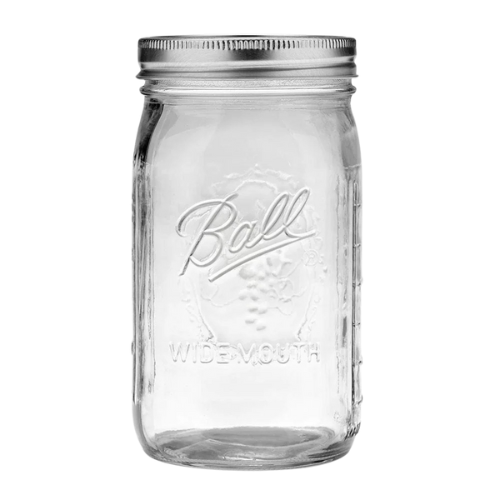
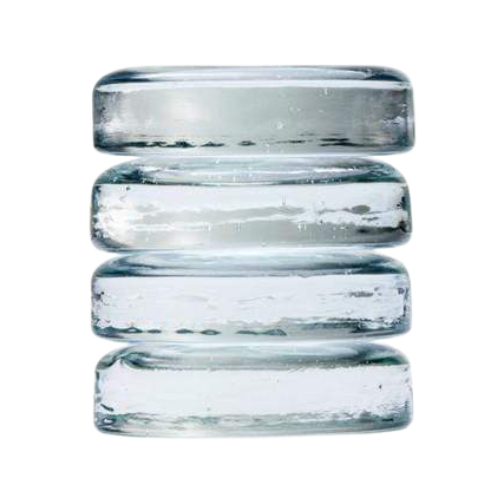
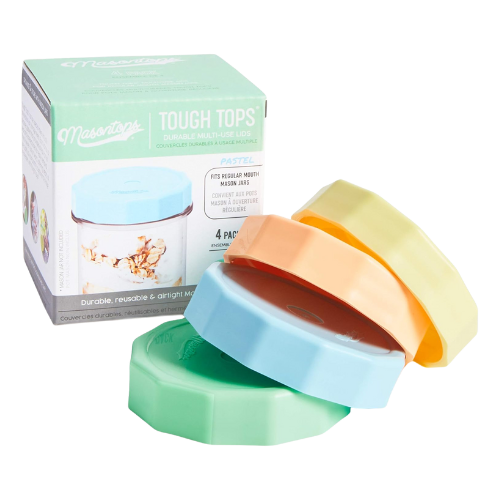
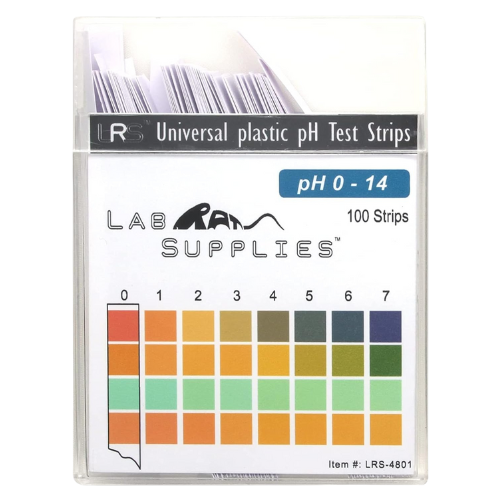
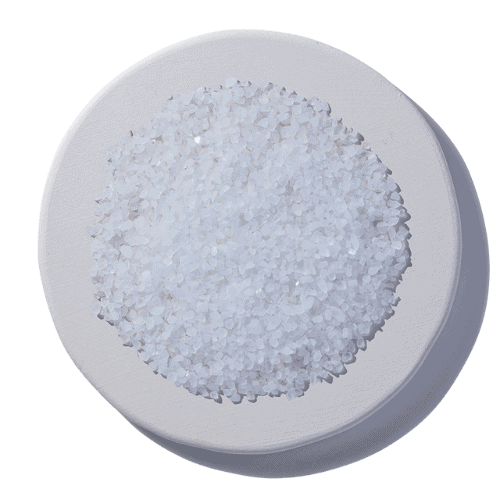
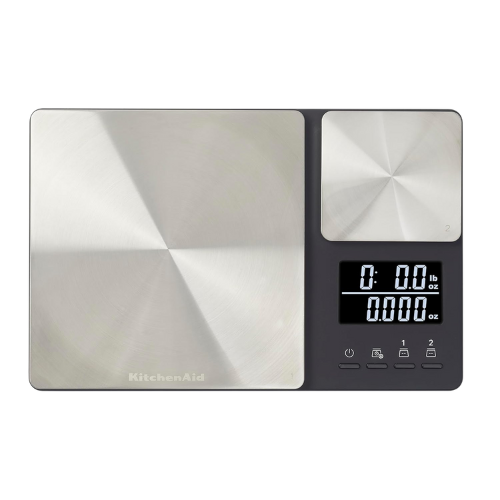


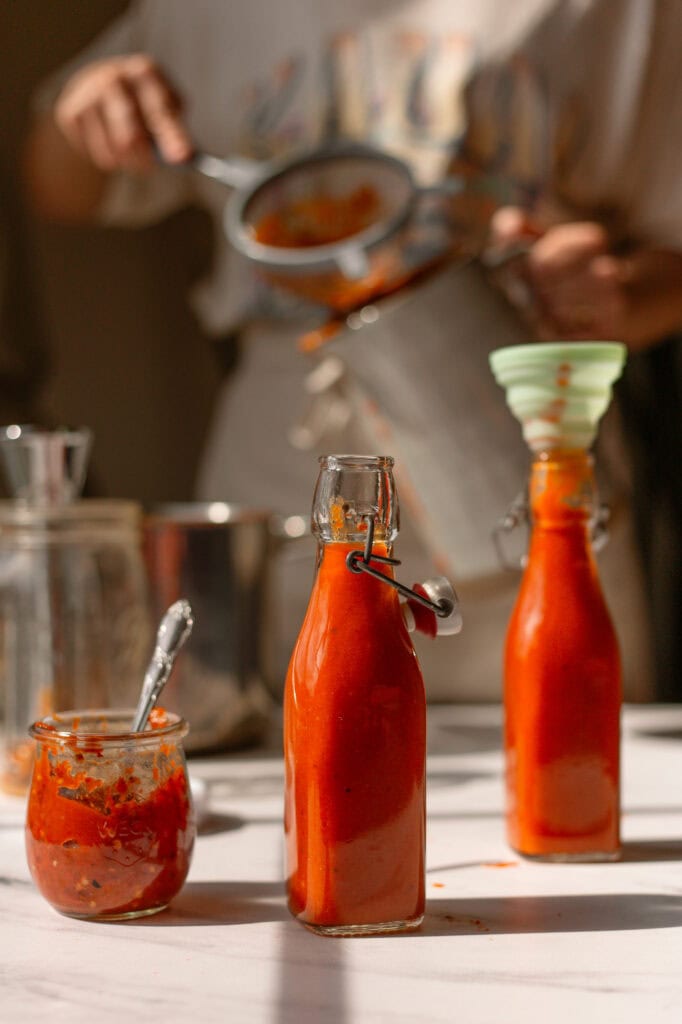





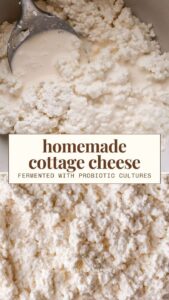
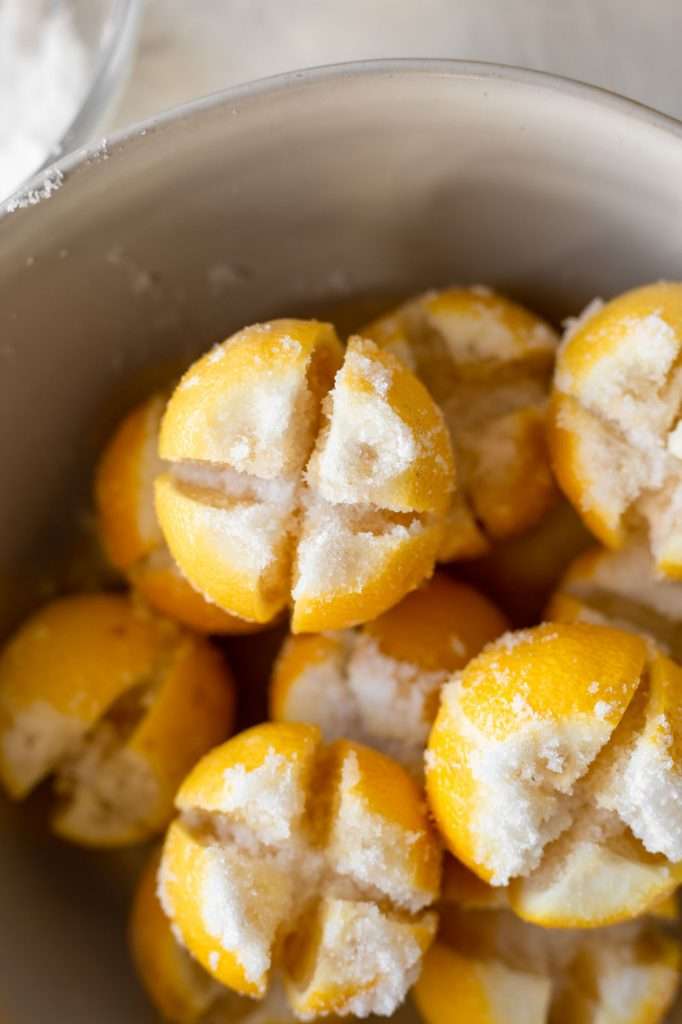
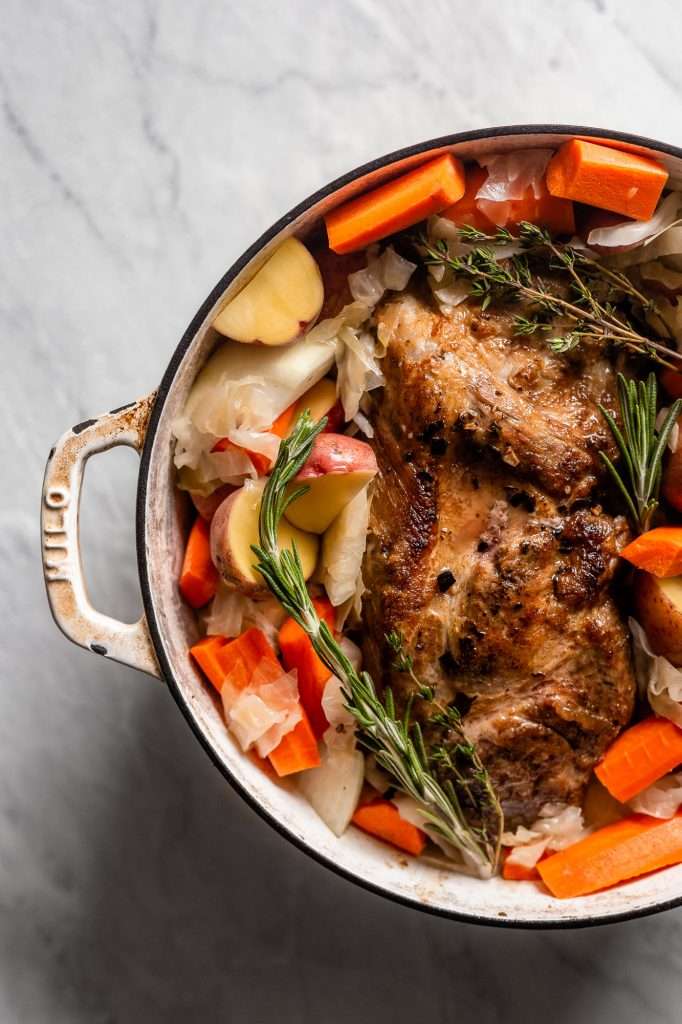
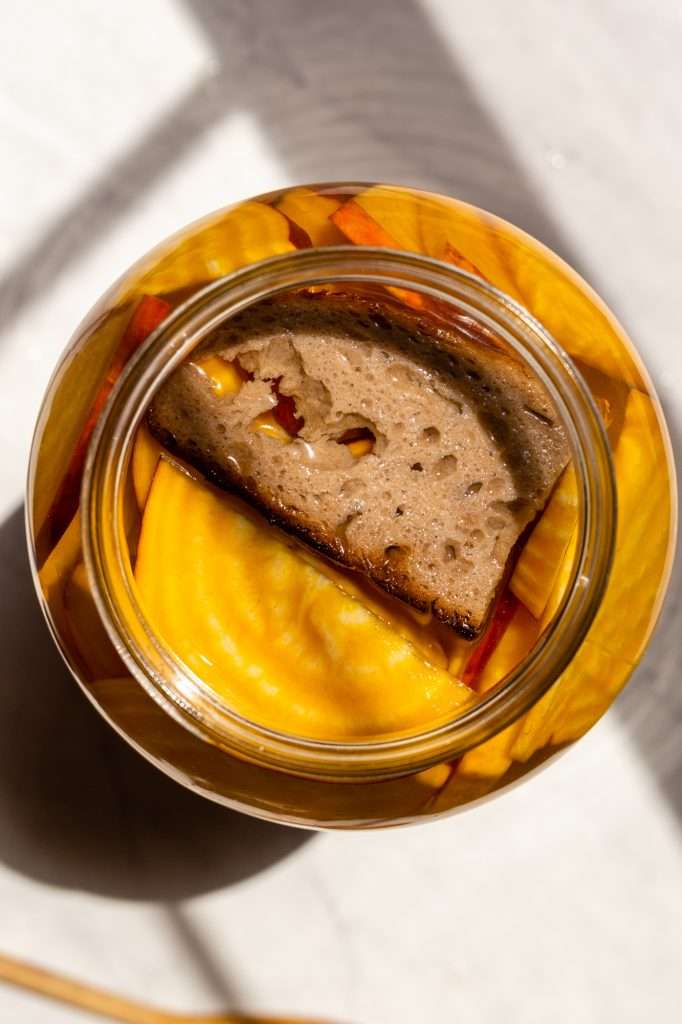

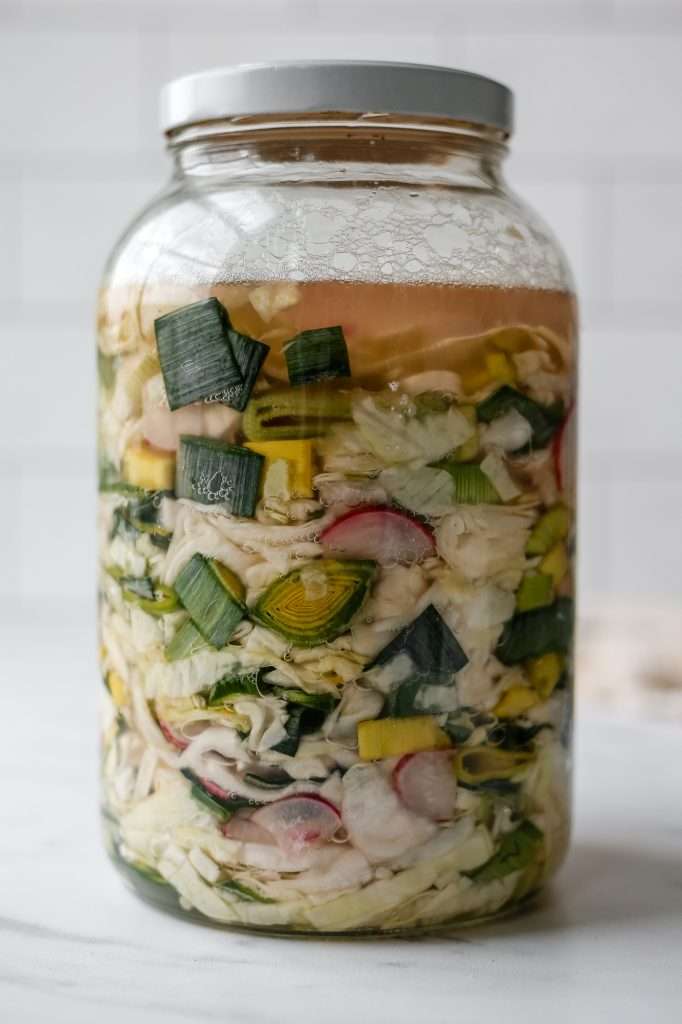



I can’t wait to try it! I’m wondering, could you use fresh ginger root instead?
You can, but I wouldn’t add much for it to be an even substitute. I wrote the recipe with ginger powder in the spice blend, because that’s how we made the kimchi that we used to sell in Whole Foods.
Why did y’all stop selling it at Whole Foods? I love your products. I have stomach issues and your sauerkraut and kimchi has helped me tremendously.
Our products were well loved and a great success, and I am glad you enjoyed them. We closed our food business because running a food business was not getting us any closer to the kind of life we want to live. We are happier than ever to be done with that chapter and focusing on this blog and our online courses.
I’m happy that you have the recipe on your website. I made my first batch of kimchi and I can’t wait to see how it comes out. Good luck on your new journey and thanks again for having these recipes on your website.
My batch is now two weeks old. One more week and we dig in. Also tried the dill/roast jalapeño/garlic one. Can’t wait!
My Grandma made “Chow Chow.” She was raised on a Farm in Fort Smith Arkansas.
I am amazed how much better we ate back then. No eating out as my Grandpa would not have it.
You take me back.
I love to hear that I take you back to those times. My husband and don’t eat out at all (unless it’s vacation or an emergency type situation) because I won’t have it lol. Homemade is far superior.
Any concerns in fermentation if I leave out the garlic and scallions (allium allergy)? Thank you for the recipe.
It won’t taste the same without it, but there are no fermentation concerns. You can leave it out.
Why did you rate our recipe less than 5 stars when you have not tried it yet?
My favorite kimchi in the whole world. I can’t wait to regularly make this at home!
Will be trying this very soon! Curious if the salt is a ratio to the weight of all veggies. I ask, because I’d like to add some daikon radishes. Really impressed by your blog.
the salt is about 2.5% of the weight of all the vegetables and water added.
Of course it is! I forgot your research advice 🤦♂️
I love kimchi but I much prefer white kimchi. Do you have a recipe to share?
Thank you!
I do not have a white kimchi recipe at this time.
I’m so excited to try this recipe! I’ve been eagerly awaiting a kimchi-style recipe from you after making your regular sauerkraut and loving it. I’m wondering, for the dry spice mix, you say minced garlic. Is that meant to be fresh minced garlic, or dried garlic powder/granules?
Hi there! for the dried spice mix, all the ingredients are dried. It’s meant to be dried minced garlic. Most places sell different cuts/grinds of dried garlic.
Awesome! Thanks for the clarification.
Is this supposed to ferment on the counter or in the fridge? I just made it and I can’t wait until it’s ready!
It ferments at room temperature.
Thank you! I know it says 21-28 days, but is there a specific sign to look for that tells you it’s ready?
What type of sea salt do you use? Does it have to be the chunky kind or can I use redmond real salt?
You can use any sea salt you want. as long as you measure it by weight on a kitchen scale.
This is EXACTLY like the kimchi you used to sell at whole foods! Thank you for giving us this recipe for free!
My husband and I are going to make this but I don’t like my Kimchi crazy hot. It seems like 455 grams of chili flakes is a lot. The bag I purchased is 8 ozs. Can’t imagine using 2 of these bags! Is that correct?
You don’t use the entire mixed spice blend in one recipe. You mix the spice blend and then use 15 grams of that spice blend in the recipe, as the recipe states.
OMG! If course… wasn’t paying attention.🤦♀️. Thanks! Cant wait to make it!
Can you share links for the kelp and chili flakes?
It’s seriously so good! Perfectly spicy & crunchy!! Husband and I eat it everyday. Next time I’m just going to make double right away 😂
Thank you for sharing so many wonderful, healing recipes! Forever thankful I found your blog 🖤
Just started my fermenting at home journey and this recipe looks amazing and so easy to follow – thank you! Would using an airlock lid prevent the need to burp the jar? And if I have a starter culture (Cutting Edge Cultures), would I still need to ferment for 21-28 days?
Welcome to our blog! You won’t need to burp the jar with an airlock lid. I wouldn’t recommend using those silicone “airlocks” though. Also, I don’t usually recommend using starter cultures with my recipes. You should still ferment for the same amount of time, even with a starter.
Could one use dulse flakes in place of the kelp flakes?
yes!
I LOVE this Kim chi and have made it several times. I tripled my current batch and used a large Weck jar. It is week 2 and I’m noticing that although to start it was very full of liquid it is now looking dry and I have to keep pushing the kraut down to keep it covered. Would you recommend adding brine? If so, what concentration?
Looks amazing! Could I make this with fresh ginger and garlic? If so how much? Thanks!
You can! I’d say 1 to 2 garlic cloves and maybe a teaspoon or two of grated ginger.
Made this and really appreciated the specifics of this recipe including the extra water, units in grams, and easy to use spice mix. I have had fermenting fails in the past because I have not used the same salt as the recipe or have guesstimated too much and so I appreciate that you are scientist and do not leave room for error or guessing in this recipe (my background is in science too.) I used pink Himalayan salt. I love it so much and I am currently making another batch! Each time I doubled the recipe. The first time I made it with Napa cabbage and this time I am trying with regular green cabbage. Made this and the traditional sauerkraut recipe, which I just tasted and put in the fridge today after a 3 week for a minute, it is delicious also. I have a big crock so I tripled the sauerkraut recipe.
WOW! I just made my first batch today with fresh Napa cabbage that was grown in my garden. It smells so good already, how am I going to wait for it to ferment to eat?!
One question, there is a lot of liquid at the top of my fermentation jar. I assume it may be because my cabbage was extremely fresh, harvested a couple days ago, and has a high water %. Do you anticipate that this will have any effect on the finished product? I am going to be making another batch tonight and was wondering if i should reduce the amount of water added.
Having a lot of brine is great. It will be perfect if you followed the weight measurements in the recipe. The reason my vegetable fermentation recipes are all written with weight measurements is to account for variations in cabbage water density. You should not reduce the amount of water added. Later on in the fermentation process, the cabbage will absorb some of the brine back in.
Hi Kaitlynn! Excited to try this recipe! Would using red cabbage instead of green work the same? Thank you!
You can use red cabbage! It ferments a little differently (more bubbles), but it will be the same.
I love this spice blend! I made a double batch of the kimchi kraut and still had cabbage so I made Cole slaw and stirred your spice blend into the dressing. It is awesome! I can’t wait for the kraut to be ready to eat!
If I make kimchi using a glutinous rice porridge method what impact does this have on the fermentation in terms of probiotic diversity? Does it skew the types of beneficial bacteria in any particular direction? I suppose i’m asking if using the porridge method is less beneficial to health in terms of probiotic bacteria. Great website by the way. Looking at signing up for your online courses. TIA
the more ingredients you add, the more variable the microbial community. I wouldn’t say that one is better for health than the other. They’re just different. How long this one is fermented vs how long baechu kimchi is usually fermented has more impact on the available health benefits.
Excited to give this recipe a whirl. Having served in Germany and South Korea, I have set a goal to attempt to recreate the flavors at home, now that I am retired. My sauerkraut recipe has evolved to where it is perfect every time, but I’ve hesitated to try making Baechu, as my crock adventures in Florida have not proven to have much success. This hybrid sounds intriguing and I just created my first batch. I will certainly follow up with comments and observations once taste testing begins. For now, thank you!
Love this! It is the best!
I’ve made this a few times and it never fails to be delicious and impress anyone I’ve given it to. It’s one of my go to ferment recipes (along with your apple sauerkraut one) whenever I get cabbage in my CSA box. I’ve shared your website with so many people and plan to take your classes at whatever point I haven’t overbooked myself with other learning endeavors lol. Thank you so much!!
Thank you for leaving a review! and thank you for spreading the word about my recipes! That’s so nice of you.
I loooove Kimchi and can’t wait to make this recipe. I do like the flavors of the traditional Kimchi. Would it be ok to add dried shrimp, anchovy or fish sauce to the mix?
Thanks!
We always have this “kimchi” in our fridge. My bf travels a lot to Korea and it’s still his favorite! We love that it is crunchy and I love that it’s no fail since I’ve had soooo many inconsistent results with other kimchi recipes in the past!!! Thank you so much for this recipe!
Is it concerning if it becomes cloudy too early – like day 3?
Nope, that means it’s going well! It’s supposed to get cloudy. That’s the microbes growing.
We love our kimchi, especially with a crunch! Napa gets a little soggy but this is perfect.
Finally getting around to making this soon! The gochugaru on the Starwest site says powder but in the photo it looks fairly flakey. Is that what you use or should I search elsewhere for actual flakes? Many thanks for this recipe. I used to buy from your shop and this was my favorite.
I think their “powder” is flakey. That’s what we used when we used to produce products! It pretty much dissolves in the brine.
Thank you!
Brilliant recipe. I added mooli and kelp strips. Two jars made, eaten in days. Next batch on the go. Thank you.
Great! Ready to make a second batch!
Thank you for leaving a review! I’m glad you love the sauerkraut!